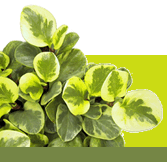|
 Peperomias may be found in subtropical & tropical regions all around the world although most species occur in Central America and Northern South America. Botanical as well as cultivar specimens found in plant shops are selected because they are easy to grow under greenhouse or indoor conditions. Peperomias may be found in subtropical & tropical regions all around the world although most species occur in Central America and Northern South America. Botanical as well as cultivar specimens found in plant shops are selected because they are easy to grow under greenhouse or indoor conditions.
General horticulture
 Decorative foliage Peperomias: most of them grow as epihytes in rain or cloud forest habitats. This means they need high air humidity. Because of their epiphytic growth they don’t have permanent access to ground water. Usually they have a small root system and leaves and stems are more or less succulent to support drying out of the substrate. The substrate has to contain air. Stagnating water will cause stem rot and overwatering is the main cause of loosing these plants. On the other hand water spraying to rise the air humidity is important surely when temperatures are higher. These Peperomias don’t need a rest period. By temperatures between 20° and 24°C they will grow year round. Prevent direct sun exposure in summer. Decorative foliage Peperomias: most of them grow as epihytes in rain or cloud forest habitats. This means they need high air humidity. Because of their epiphytic growth they don’t have permanent access to ground water. Usually they have a small root system and leaves and stems are more or less succulent to support drying out of the substrate. The substrate has to contain air. Stagnating water will cause stem rot and overwatering is the main cause of loosing these plants. On the other hand water spraying to rise the air humidity is important surely when temperatures are higher. These Peperomias don’t need a rest period. By temperatures between 20° and 24°C they will grow year round. Prevent direct sun exposure in summer.
 Succulent Peperomias: are mostly high altitude plants. They are used to a warm season followed by a cold season both with limited rainfall. Their succulence protects them against direct sun exposure during the summer as well as against dry conditions during winter. Always water moderately and don't give any when temperatures are low. Succulent Peperomias: are mostly high altitude plants. They are used to a warm season followed by a cold season both with limited rainfall. Their succulence protects them against direct sun exposure during the summer as well as against dry conditions during winter. Always water moderately and don't give any when temperatures are low.
 Geophytic Peperomias: these plants protect themselves against drought by their tubers. Leaves die off in the dry season and appear again when more rain falls. They need a time of rest with low temperatures (5°C to 10°C will be sufficient) Geophytic Peperomias: these plants protect themselves against drought by their tubers. Leaves die off in the dry season and appear again when more rain falls. They need a time of rest with low temperatures (5°C to 10°C will be sufficient)
Propagation
 Although some Peperomias are propagated by seed (e.g. the annual species), most of them are propagated vegetatively by cuttings. Leaf cuttings are standard. Variegated cultivars (chlorophyllic chimeras) are propagated by top cuttings. When propagated by leaf cuttings they will loose their variegation. Although some Peperomias are propagated by seed (e.g. the annual species), most of them are propagated vegetatively by cuttings. Leaf cuttings are standard. Variegated cultivars (chlorophyllic chimeras) are propagated by top cuttings. When propagated by leaf cuttings they will loose their variegation.
 Propagation by cuttings: step-by-step [external link] Propagation by cuttings: step-by-step [external link]
Diseases
 Parasitic diseases cause minor problems to Peperomias. Fungal diseases are the main cause of loosing plants. Parasitic diseases cause minor problems to Peperomias. Fungal diseases are the main cause of loosing plants.
 About Peperomia diseases [external link] About Peperomia diseases [external link]
Cultivars
 Cultivars (cultivated varieties) are spontaneous or induced mutations occurring under artificial growing conditions. The characteristics that distinguish them from their botanical parents are often not stable when the cultivars are propagated by seed. To maintain the new characteristics, most cultivars are propagated vegetatively (by cuttings or micropropagation). Peperomia caperata has undoubtfully the most cultivars. Peperomia obtusifolia has quite a few too. A special group are the chlorophyllic chimeras (with variegated leafs). These plants contain two genetically different types of tissue. The difference concerns the amount of chloroplasts (cell organelles containing chlorophyll). Cultivars (cultivated varieties) are spontaneous or induced mutations occurring under artificial growing conditions. The characteristics that distinguish them from their botanical parents are often not stable when the cultivars are propagated by seed. To maintain the new characteristics, most cultivars are propagated vegetatively (by cuttings or micropropagation). Peperomia caperata has undoubtfully the most cultivars. Peperomia obtusifolia has quite a few too. A special group are the chlorophyllic chimeras (with variegated leafs). These plants contain two genetically different types of tissue. The difference concerns the amount of chloroplasts (cell organelles containing chlorophyll).
 Background info about chlorophyllic chimeras [external link] Background info about chlorophyllic chimeras [external link]
|

